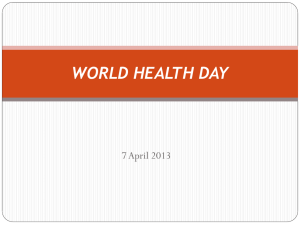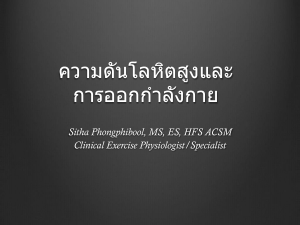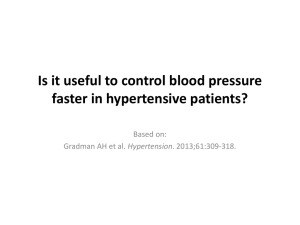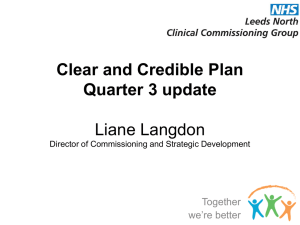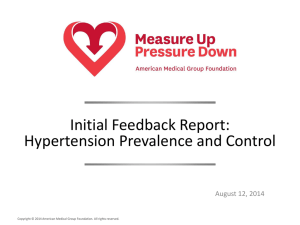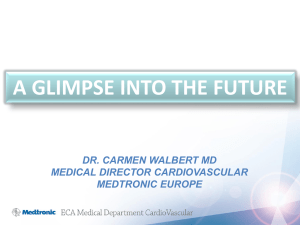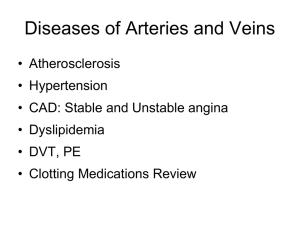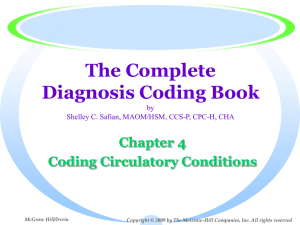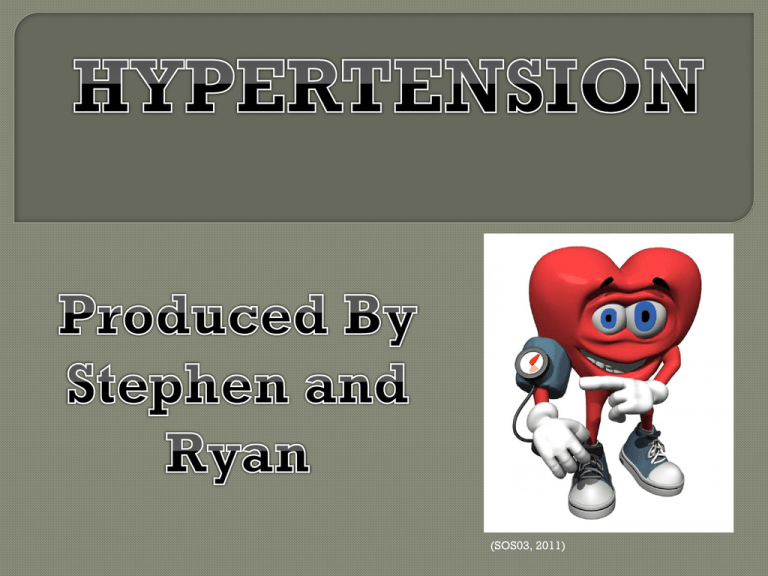
(SOS03, 2011)
‘Hypertension, also referred to as high blood pressure, is a condition in
which the arteries have persistently elevated blood pressure. Every time
the human heart beats, it pumps blood to the whole body through the
arteries.’ – (Medical News Today, 2013)
‘High blood pressure (hypertension) means that your blood is pumping
at a higher pressure than normal through your arteries.’ – (Better
Health Channel, 2013)
http://www.youtube.com/watch?v=j_Hm0
zQ6XQ8
• In most cases - No obvious symptoms associated with Hypertension.
• Hypertension can be present in the body, even if a person is physically feeling
well.
• Hypertension can only be detected by having it checked from a health
professional. Checks should occur at least once annually.
• Hypertension is measured by a Sphygmomanometer, which records two
readings: Systolic – ‘Is the highest pressure against the arteries as the heart
pumps.’ Diastolic – ‘Is the pressure against the arteries as the heart relaxes
and fills with blood.’
• Normal systolic pressure – Between 110-130mmHg
• Normal diastolic pressure – Between 70-80mmHg
Source: Better Health Channel, Heart Foundation
(Wholify, 2013)
•
The physical concerns of Hypertension are mainly located in vital
organs and functions of the body.
•
Heart – The heart is at a high risk of having a heart attack due to
hypertension. Chest pains, called ‘angina’ can occur. This is caused
by the heart not receiving enough oxygen from the arteries.
•
Congestive Heart Failure (CHF) is when the heart is unable to pump
sufficient blood to the body. This is caused by weakened chambers,
which allows blood to pool into the heart and veins. Hypertension is
the highest risk factor for CHF.
•
Kidney – Kidneys filter the body's waste. Hypertension can thicken
and narrow blood vessels of the kidneys. As a result of this, the
kidneys may filter less waste and potentially cause a build up. This
may cause kidney failure.
Source: NHLBI
• Arteries in the body harden, as people age. Hypertension causes
arteries to become stiff and more hardened. This causes the kidneys
and heart to work their muscles harder.
•
Eyes – Blood vessels in the eye may burst due to Hypertension. This
may cause partial or full blindness.
• Hypertension causes blood clots to occur. This can cause narrow
arteries to become blocked and cause a stroke.
Source: NHLBI
(Blogspot, 2013)
(1990 - 2000 Data, Australian Residents)
Source: AusDiab
• A Heart Foundation Survey completed in 2010 found one in three
Australians aged 30-65 years had been told by a doctor that they have
high blood pressure. This equates to roughly 3.5 million Australians.
•
There is evidence for the US, Australia and Korea indicates that men have
slightly higher pressures than women and slightly greater prevalence of
hypertension.
•
In the US, the sex difference is reversed at about age 70 and persists
throughout the rest of the lifespan. How much these gender differences
affect gender differences in cardiovascular disease is not clear.
Source: Dunstan HP
(Wikimedia, 2012)
• Hypertension remains one of the leading causes of death in Australia,
accounting for 47,637 or 36% of deaths in 2004.
•
Hypertension is one of the largest causes of premature death in Australia.
• Hypertension accounts for 19% of all deaths of males, and 18% of all deaths of
females. Stroke has been the second most common cause of cardiovascular
death since 1968, causing 7% of all deaths for males and 11% of all deaths for
females in 2004.
Source: Australian Bureau of Statistics
(Deviantart, 2013)
• Diseases of the circulatory system were responsible for around 27% of total
Indigenous male and female deaths for the period 2001-2005. In comparison,
these diseases accounted for 34% of all male deaths and 40% of all female
deaths for non-Indigenous Australians.
• Heart attacks and Angina were responsible for 64% of Indigenous male deaths
and 49% of Indigenous female deaths, while stroke (caused by Hypertension)
accounted for 14% of male deaths and 19% of female deaths.
• Compared with non-Indigenous Australians, Indigenous males and females
experienced higher rates of mortality from diseases of the circulatory system in
every age group. This is because the lifestyle of Indigenous Australians has
changed (hunter-gather).
• Alcohol, physical inactivity, nutrition, overweight and obesity highly increases
the chance of having Hypertension in Indigenous Australians.
Source: Australian Bureau of Statistics
(2001 – 2005)
Source: Australian Bureau of Statistics
(2001 – 2005)
Source: Australian Bureau of Statistics
High Saturated
Fat Diet
Family History of
Hypertension
High Salt Diet
Risk Factors
Unhealthy
Lifestyle
People aged over
55
•
An unhealthy lifestyle and diet is a high risk factor of Hypertension.
•
A high salt and/or saturated fat diet significantly increases the risk of
Hypertension. This is because it causes cholesterol levels to rise in the
body, clogging up arteries.
•
People aged 55 and over have a higher chance of having Hypertension,
as the risk of having Hypertension increases with age.
•
Women are less likely to have Hypertension, compared to men.
•
A family history of having Hypertension increases the risk of inheriting
it.
Source: Better Health Channel, Craig Webber
•
•
•
•
•
•
•
•
•
•
Lack of exercise
Heavy drinking
Obesity
A diet consisting of high salt
Kidney disease
Cigarette smoking
High levels of saturated fat in diet High blood cholesterol
Diabetes
Drugs (Contraceptive pill, non-steroidal anti-inflammatories, some
nasal drops and sprays, cough medicines, eye drops and appetite
suppressants.
Source: Better Health Channel
• Hypertension can be easily managed by healthier lifestyle and diet choices,
as the main causes of Hypertension are diet and lifestyle related.
• Consistent exercising – At least 30 minutes a day of exercise is essential for
maintaining a healthy lifestyle. This can include: Light jogging, power
walking, dancing or swimming.
• Avoid heavy lifting, as it causes the heart to pump more blood.
• Reducing saturated fat and salt intake.
• Avoiding processed foods (Processed meats, take-away, potato crisps, frozen
foods and salted nuts).
• Consuming nutrient-dense foods (Vegetables, wholegrains, rice, fruits, oily
fish, nuts, legumes, milk, yoghurt and lean meats).
• Drinking a sufficient amount of water daily (8 glasses or 2 litres).
• DASH Diet – This diet has an emphasis on real foods, heavy on fruits and
vegetables, balanced with the right amount of protein, DASH is the perfect
weight loss solution.
Source: Health Insite, Better Health Channel
• No obvious symptoms with Hypertension
• Mainly caused by lifestyle and diet factors.
• Can easily be managed by modifying
lifestyle and diet.
•
30 Minutes of light exercising each day.
• Sufferers should avoid heavy lifting.
• Consuming more nutrient-dense foods and
reducing processed foods.
• Less salt and saturated fat in diet.
(Zahlmann, 2013)
Medical News Today (2013), What is Hypertension http://www.medicalnewstoday.com/articles/150109.php
Accessed 2nd May 2013
Better Health Channel (2013), High blood pressure (Hypertension)
http://www.betterhealth.vic.gov.au/bhcv2/bhcarticles.nsf/pages/Hypertension_means_high_blood_pressure
Accessed 2nd May 2013
Heart Foundation (2013), Cardiovascular conditions http://testing.heartfoundation.org.au/your-heart/cardiovascular-conditions/Pages/bloodpressure.aspx
Accessed 3rd May 2013
NHLBI (2013), Effects of high blood pressure http://www.nhlbi.nih.gov/hbp/hbp/effect/effect.htm Accessed 3rd May 2013
AusDiab (2001), Hypertension Statistics 1990-2000
http://www.health.gov.au/internet/main/publishing.nsf/Content/4C844161B2A939BECA25714C00075738/$File/ausd5.pdf Accessed 5th May 2013
Dunstan HP (1996), Gender differences in hypertension http://www.ncbi.nlm.nih.gov/pubmed/8872794 Accessed 5th May 2013
Australian Bureau of Statistics (2010), The Health and Welfare of Australia's Aboriginal and Torres Strait Islander Peoples
http://www.abs.gov.au/ausstats/abs@.nsf/0/8F08EF0297F11CC6CA2574390014C588?opendocument Accessed 5th May 2013
Craig Webber (2007), Top 10 high blood pressure risk factors http://highbloodpressure.about.com/od/understandyourrisk/tp/risk_tp.htm Accessed
5th May 2013
Health Insite (2013), Is your blood pressure healthy? http://www.healthinsite.gov.au/article/your-blood-pressurehealthy?utm_source=google&utm_medium=cpc&utm_term=high%20blood%20pressure&utm_campaign=Articles+(B)%20Look%20up%20Dash%20di
et Accessed 6th May 2013
Dash Diet (2013), The dash diet eating plan http://dashdiet.org/ Accessed 7th May 2013
Sphygmomanometer picture (2013), Wholify http://www.wholify.com/public/Hypertension-Nutrition-Counseling.jpg Accessed 7th May 2013
Heart cartoon (2011), SOS03 http://www.sos03.com/Diseases/Vascular/Arterial_Hypertension Accessed 1st May 2013
Human body (2013), Blogspot http://4.bp.blogspot.com/--imbp14105A/US9isNwX6vI/AAAAAAAABnI/3cB6aqFRovI/s1600/Magnetic_Human_body_11000x1000.jpg Accessed 7th May 2013
People exercising (2013), Zahlmann http://2.bp.blogspot.com/-YgihpeQQNw8/T0gkhBrlQ2I/AAAAAAAAEGI/8MtntPh7hqo/s1600/keep-exercising.gif
Accessed 8th May 2013
World Map (2012), Wikimedia http://upload.wikimedia.org/wikipedia/en/7/72/World_Map_WSF.svg.png Accessed 7th May 2013
Mortality (2013), Deviantart http://mysticalpha.deviantart.com/art/Mortality-284613783 Accessed 8th May 2013

